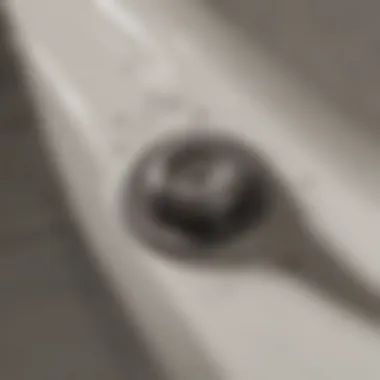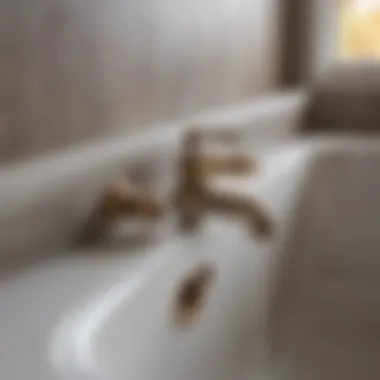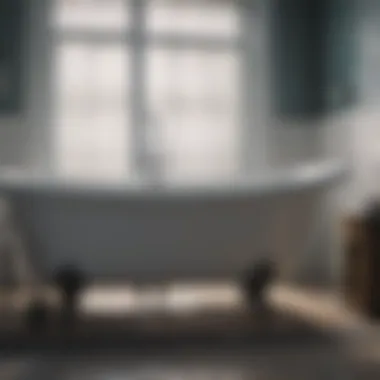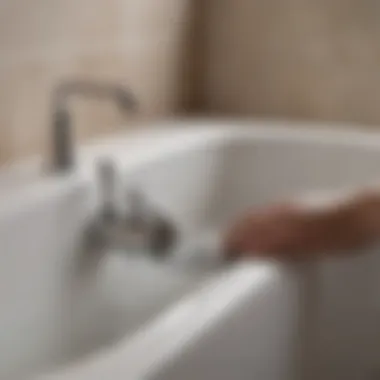Understanding Bathtub Drainage Issues: Causes & Solutions


Intro
Bathtub drainage issues can be particularly frustrating for homeowners. A slow or non-draining bathtub not only disrupts daily routines but can also indicate deeper plumbing problems. Understanding these issues creates the groundwork for effective solutions. This guide explores common causes of draining problems, introduces systematic diagnosis strategies, and offers practical solutions to empower homeowners.
The Importance of Proper Drainage
Proper drainage is critical for both comfort and functionality in the bathroom. When a bathtub does not drain effectively, it can lead to stagnant water, fostering a breeding ground for bacteria and unpleasant odors. Moreover, persistent drainage issues, if left unresolved, may escalate into more costly plumbing repairs. Understanding the mechanisms of bathroom drainage is essential for prolonging the life of your plumbing system.
Homeowners who proactively address drainage problems can save time, money, and stress. This guide aims to provide clear, actionable insights to diagnose and rectify tub drainage issues. In doing so, you'll gain the knowledge necessary to maintain a comfortable and sanitary bathroom environment.
Key Points to Be Discussed
- Common Causes of Drainage Issues
- Steps for Diagnosis
- Practical Solutions
- Maintenance Practices
- Mechanical obstructions
- Design flaws in plumbing
- Visual inspection techniques
- Testing drainage capacity
- DIY repair methods
- When to call a professional
- Daily upkeep strategies
- Long-term prevention tips
This article will serve as a comprehensive guide to diagnosing and solving bathtub drainage problems, ensuring that your home remains a relaxing sanctuary.
Prologue to Bathtub Drain Problems
Bathtub drainage issues can disrupt daily routines and lead to larger plumbing problems if not addressed promptly. Understanding the common complications that arise with bathtub drainage is essential for homeowners. Effective drainage is crucial not only for immediate comfort but also for preventing future headaches related to plumbing.
Why Drainage Matters
The functionality of a bathtub is heavily dependent on its drainage system. When water accumulates, it not only hinders usability but can also create a breeding ground for mold and bacteria. As such, efficient drainage processes are vital for maintaining a healthy home environment.
Here are some reasons why proper drainage is significant:
- Health Concerns: Standing water can attract pests and promote the growth of harmful microorganisms.
- Structural Integrity: Prolonged exposure to excess moisture can lead to water damage in floors and walls.
- Convenience: A functioning drain ensures that usage of the bathtub remains practical, minimizing disruptions in daily life.
Neglecting drain issues may lead to more extensive and costly repairs, making it important to recognize and rectify these problems early.
Common Bathtub Drain Issues
Bathtubs can experience several drainage issues that range in complexity and severity. Here are some of the most common problems:
- Clogs: Perhaps the most frequent issue arises from hair, soap residue, and other materials that block the flow.
- Slow Draining: This sign may indicate partial clogs, suggesting that the blockage is forming.
- Leaking Drain: A leaky drain can lead to water pooling around the base of the tub or floor.
- Faulty Overflow Drain: If the overflow mechanism isn’t functioning properly, it can cause problems that lead to water damage.
Recognizing these issues early can provide homeowners a clearer path toward resolution, whether through simple DIY fixes or by seeking professional help.
Understanding the Drain Mechanism
Understanding the drain mechanism is fundamental for homeowners who want to resolve bathtub drainage issues effectively. The drainage system does not merely serve to carry water away; it is a carefully designed network of parts working together to ensure smooth water flow. When problems arise, it is often due to failures or inefficiencies in this system. Recognizing how each component functions can illuminate the path to effective remedies for common drain problems.
In this section, we will take a closer look at the components of the bathtub drain, exploring their roles and significance within the overall drainage mechanism. A sound grasp of these elements allows homeowners to pinpoint issues more accurately, leading to timely and efficient resolutions. Furthermore, this knowledge empowers homeowners to perform regular maintenance that can prevent future issues.
Components of a Bathtub Drain
The bathtub drain consists of several key components, each contributing to its overall efficiency:
- Drain body: This is the visible part of the drain. It collects water from the tub. A well-functioning drain body ensures the water flows smoothly.
- Strainer: Positioned at the top of the drain, the strainer catches larger debris, like hair and soap. Regular cleaning of the strainer is crucial to avoid clogs.
- Overflow pipe: This pipe leads excess water away if the bathtub overflows. It plays a critical role in preventing water damage.
- P-trap: A curved pipe that retains water, blocking sewer gases from entering the home. This is essential for a healthy indoor environment.
- Drain stopper: This component helps seal the drain when the tub is filled. It can be manual or automatic, depending on the model installed.
Each of these components must be operating correctly to maintain the functionality of the bathtub drainage system. Any failure in one part can lead to a cascading series of issues, ultimately affecting the entire household plumbing network.
Importance of Proper Functionality
Proper functionality of the bathtub drain mechanism cannot be overstated. Each component relies on the others, and when one fails, it can lead to irritating issues like slow drainage or even complete blockage. Here are some key reasons why functionality is important:


- Preventing Water Damage: A malfunctioning drain can cause water to overflow or back up. This situation can damage flooring, walls, or the foundation of your home.
- Health Considerations: Poor drainage can create stagnant water which fosters the growth of mold and bacteria, posing health risks to the household members.
- Efficiency: A well-functioning drain allows water to flow freely. This efficiency saves time and energy, contributing to a smoother daily routine.
Proper functionality is not merely a cosmetic issue; it is essential for maintaining a safe and healthy living environment.
Keeping each component in good working condition is crucial for avoiding future problems. Regular checks and maintenance can help identify wear and tear before they escalate into more serious issues.
Identifying Causes of Drainage Failures
To effectively troubleshoot and resolve bathtub drainage issues, identifying the root causes of failures is paramount. Understanding these causes helps homeowners not only to rectify existing problems but also to prevent future occurrences. Drainage failures often lead to frustration and potential water damage, which can be costly both in repairs and in terms of time lost. Therefore, a systematic approach to diagnosing the issue is essential.
Key elements include recognizing the specific signs of each type of failure and understanding how different factors contribute to drainage problems. Benefits of properly identifying the cause range from informed repair decisions to improved overall household maintenance. This section elucidates three pivotal causes that frequently lead to drainage failures: clogs from hair and soap residue, sediment buildup in pipes, and faulty drain valves.
Clogs from Hair and Soap Residue
Hair and soap residue are among the most common culprits of bathtub drain clogs. Over time, hair can accumulate in the drain, intertwining with soap scum and forming a dense blockage. This issue often sneaks up on homeowners, as the buildup may be slow and subtle at first.
When water starts draining slowly or backs up, it is a clear indication that clogs are forming. Here are some key points:
- Prevention: Regularly removing hair from the drain can significantly reduce accumulation.
- Detection: Using a flashlight to examine visible portions of the drain can reveal early signs of blockage.
- Resolution: A simple solution may involve using a drain snake or a plunger to dislodge the clog.
Taking proactive measures can save homeowners from more complicated solutions later on.
Sediment Buildup in Pipes
Sediment buildup in pipes arises from minerals present in the water supply, particularly in areas with hard water. Over time, these minerals can coat the insides of pipes, narrowing their diameter and impeding proper water flow. This gradual reduction can lead to headaches when trying to clear blockages.
Signs of sediment buildup include:
- Decreased water pressure.
- Unusual noises when water flows through the drain.
Cleaning pipes often involves specific chemicals or professional plumbers to undertake hydro-jetting. Regular cleaning and maintenance of the pipes can mitigate these issues, prolonging the lifespan of the plumbing system.
Faulty Drain Valves
Faulty drain valves can prevent water from exiting the bathtub altogether. Valves are essential components in controlling water flow, and any malfunction can lead to significant drainage problems.
Signs of a faulty valve include:
- Water remaining stagnant in the tub.
- Visible leaks around the drain mechanism.
Identifying and replacing a faulty valve requires careful examination. Homeowners should also consider checking whether the valve is compatible with their existing plumbing system to avoid further complications.
Assessing the Situation
Assessing the condition of your bathtub drainage system is a crucial step in successfully addressing related issues. This examination helps homeowners to diagnose problems accurately, leading to practical solutions. Moreover, understanding the existing state of your drainage allows for better prevention strategies in the future, reducing the chance of further complications.
Checking the drain contributes directly to maintaining the overall plumbing health of a home. Ignoring potential problems can result in more significant issues, such as water damage or mold growth, which are time-consuming and costly to remedy. Thus, taking the time to assess the situation is an investment in the functionality and longevity of a bathtub.
Visual Inspection of the Drain
The first step in assessing the drainage issue is through a visual examination. This involves closely looking at the drain cover, surrounding areas, and any visible pipes for signs of damage or blockage. Homeowners should also examine the surface area of the tub for any leaks.
While inspecting, look for:
- Visible hair or debris: These are common culprits that can lead to clogs.
- Rust or corrosion: This can indicate age-related issues which might require repair or replacement.
- Water stains on walls: Such stains may signal that the plumbing has been leaking, even if it is not immediately obvious.
A thorough visual inspection can reveal immediate problems and provide direction for additional investigation.
Testing the Drain Mechanism
After visual inspection, testing the drain mechanism is essential. This step helps to analyze whether the lid, plug, and overall drain functionality operate smoothly. An effective way to conduct this test is by filling the bathtub with a few inches of water and observing how quickly the water drains away. If it is slow, it may indicate that a clog is present or that components are not functioning correctly.
When testing, consider:


- Listening for strange noises: Gurgling sounds can indicate air trapped in the pipes.
- Experiencing backflow: This contition occurs when water drains back into the tub rather than flowing away.
- Inconsistent drainage: If water levels fluctuate while draining, that might indicate faulty plumbing.
Monitoring these aspects will help identify any necessary adjustments or repairs needed to restore proper drain function.
Evaluating Water Flow Patterns
The final part of the assessment involves evaluating water flow patterns in and around the bathtub. Observing how water moves can provide insight into the efficiency of the drainage system. Homeowners should take note of how quickly the water drains in different scenarios, such as during a shower or a filling tub.
Pay attention to:
- Angle of the drain pipe: Poor angles can impact how water flows away.
- Durations of standing water: Extended periods without drainage suggest that a blockage is impacting flow.
- Drainage behavior during use: Observe if water drains quickly when the tub is empty and whether it slows down significantly when it’s full.
Proper evaluation of flow patterns can help homeowners to understand their plumbing system better and recognize any major inconsistencies that need attention.
Assessing the situation of bathtub drainage provides a foundation for troubleshooting. Identifying issues swiftly can lead to timely solutions and prevent any further damage. By visually inspecting, testing the mechanisms, and noting water flow, homeowners can gain a clear understanding of their bathtub’s drainage performance.
Solutions for Bathtub Drain Issues
Effective solutions for bathtub drain issues are essential for maintaining functionality and comfort in the home. Homeowners often encounter various problems related to drainage. Properly addressing these issues not only prevents further complications but also enhances the overall efficiency of plumbing systems.
In this section, we discuss three critical approaches to resolving bathtub drainage problems, ranging from simple, do-it-yourself methods to professional interventions. Understanding these solutions can empower homeowners to take decisive steps towards restoring their bathtubs to optimal working order.
Simple DIY Solutions
When faced with a clogged bathtub drain or slow water drainage, it is often reasonable to explore DIY solutions. Simple actions can yield effective results without the need for specialized skills or extensive tools.
- Using a Plunger
A common household tool, the plunger can help dislodge minor clogs. Position the plunger over the drain and apply downward pressure followed by quick pulls. This will create suction that may remove the blockage. - Baking Soda and Vinegar
A natural method involves pouring half a cup of baking soda followed by half a cup of vinegar down the drain. Allow it to sit for about 30 minutes before flushing with hot water. This reaction can break down organic material causing the clog. - Removing the Drain Cover
Take off the drain cover and visibly inspect for hair and debris. Cleaning these out can often resolve simple blockages.
By utilizing these straightforward approaches, many homeowners can successfully alleviate minor drainage issues without the associated costs of professional services.
Using Drain Cleaners Effectively
While DIY methods can be effective, sometimes stronger measures are needed. Commercial drain cleaners can be powerful solutions but come with precautions. Selecting the right product and using it properly is critical to avoid damaging plumbing.
- Choose the Right Cleaner
There are various types of drain cleaners available, including alkaline, acidic, and enzymatic options. It is vital to choose a cleaner that fits the nature of the blockage. For instance, enzymatic cleaners are less harsh and more suitable for regular maintenance. - Follow Manufacturer Instructions
Correct usage of drain cleaners is paramount. Always read and adhere to the instructions on the label. This ensures safety and effectiveness. - Flush with Water
After allowing the cleaner to work, flush the drain with hot water. This helps clear out residual cleaner and any dislodged debris, ensuring free-flowing drainage.
Despite their effectiveness, drain cleaners should not be relied upon constantly. Overuse can lead to pipe damage or further blockage.
When to Call a Professional Plumber
In some situations, it becomes clear that the issue exceeds standard DIY fixes or drain cleaners. Understanding when to seek professional help is essential for preventing further issues. Here are some indicators:
- Persistent Clogs
If your bathtub continues to drain slowly despite your efforts, there may be a deeper issue within the plumbing system. - Multiple Drainage Issues
If other drains in the home are also slow or backed up, it could indicate a plumbing system problem rather than a singular drain issue. - Foul Odors
Unpleasant smells emerging from the drain may suggest sewer line issues. This condition requires immediate attention. - Water Backup
Whenever water begins to backflow, immediate professional help is needed to evaluate the plumbing system.
Professional plumbers have the tools and experience necessary to diagnose and address plumbing issues effectively. Although it may involve additional costs, their expertise is invaluable in preventing more significant problems down the line.
It is essential to not ignore persistent drain problems. Addressing them promptly can save time, money, and further complications.
By understanding various solutions available, homeowners can tackle bathtub drainage issues effectively and maintain the overall health of their plumbing systems.
Preventive Maintenance Tips
Preventive maintenance for your bathtub drainage system is an essential aspect of home care. Implementing these tips can save homeowners considerable time and expense in the long run. Regular maintenance reduces the likelihood of sudden drainage problems, which can disrupt daily routines.
Regular Cleaning Routines
Regular cleaning routines play a vital role in maintaining the effectiveness of bathtub drainage. It is important to clear out debris and buildup from the drain on a consistent basis. A weekly schedule might include:
- Removing hair and soap residue from the drain cover.
- Flushing the drain with hot water once a week to prevent clogs.
- Using natural cleaning solutions like vinegar and baking soda monthly to break down any minor buildups.
By establishing this routine, homeowners can identify potential problems early, before they escalate into significant drainage issues.
Installing Drain Screens


Another preventive measure is the installation of drain screens. These screens act as a barrier to prevent debris from entering the drainage system. Choosing the right type of drain screen can enhance the overall plumbing efficiency. Consider:
- Material of the screen: Stainless steel screens are durable and resistant to rust, while plastic options are lighter and cost-effective.
- Mesh size: A fine mesh is ideal for catching smaller particles like hair, whereas a larger mesh may be suitable for larger debris.
Regularly cleaning these screens is crucial, as neglect can lead to blockages that may worsen over time.
Avoiding Common Drainage Mistakes
Homeowners often make simple mistakes that contribute to drainage problems. Being aware of these can help to avoid unnecessary complications. Common mistakes include:
- Using harsh chemical cleaners: Over time, these can degrade pipes and worsen drainage problems.
- Ignoring minor clogs: Small clogs can escalate into bigger issues if neglected.
- Pouring grease down the drain: This can lead to significant buildup in pipes, leading to eventual blockages.
By recognizing and actively avoiding these mistakes, your plumbing systems can function smoothly for years to come.
Maintaining your bathtub drainage system through regular cleaning, using drain screens, and avoiding common mistakes can lead to long-term benefits and prevent costly repairs.
In summary, focusing on preventive maintenance can greatly enhance the functionality and longevity of your bathtub drainage system. Taking small, actionable steps can ensure a hassle-free bathing experience.
Understanding Plumbing System Limitations
In the context of bathtub drainage issues, understanding the limitations of plumbing systems is essential. Plumbing systems are designed to facilitate the efficient flow of water and waste away from the home. However, older systems may not function as optimally as newer ones, posing a range of challenges for homeowners dealing with drainage problems. In this section, we will explore specific aspects including the impact of older plumbing systems and the materials often used in plumbing construction.
Impact of Older Plumbing Systems
Older plumbing systems can significantly affect drainage performance. The most common problem is the narrowing of pipes due to corrosion and mineral buildup over the years. These restrictions can create ideal conditions for clogs and slow drainage. Moreover, older systems often utilize outdated materials, which may not withstand modern usage demands.
Homeowners should consider several factors regarding older plumbing:
- Pipe Diameter: Many older homes feature smaller diameter pipes, which can limit flow capacity.
- Material Degradation: Older pipes may be made from materials that degrade over time, like galvanized steel or lead.
- Design Flaws: The layout of older systems may not facilitate efficient drainage, leading to problems in water flow and buildup.
Inspecting the plumbing system’s age and material can provide insights into potential drainage issues. If a home was built before modern plumbing standards were established, it may likely face drainage inefficiencies.
Materials Used in Plumbing
The materials used in plumbing systems play a crucial role in their performance and longevity. Traditional materials such as cast iron and copper are known for their durability, but they can still be problematic.
Key materials include:
- PVC (Polyvinyl Chloride): PVC is widely used in modern plumbing due to its resistance to corrosion and ease of installation. However, incorrect installation can lead to poor drainage performance.
- ABS (Acrylonitrile Butadiene Styrene): Similar to PVC, ABS is robust but can become brittle with time and exposure to heat.
- Copper: A classic choice, copper is resistant to bacteria and has a long lifespan. Failures generally occur from corrosion or joint failures.
- Cast Iron: Often used in older homes, cast iron can be effective but tends to rust over time, leading to potential blockages.
Each material has its pros and cons, influencing the effectiveness of drainage. Homeowners must understand the material characteristics, as they can affect maintenance and repair decisions.
Remember, the materials and age of your plumbing system are key indicators of your drainage issues. Knowing these can lead to preventive measures and more informed repairs.
Legal and Safety Considerations
Legal and safety considerations are pivotal when dealing with bathtub drainage issues. Understanding local building codes is essential for homeowners and landlords to ensure compliance, which can prevent future legal complications. Attention to safety during repairs is equally critical. Neglecting these factors can result in costly damage to property and pose risks to personal injury.
Building Code Compliance
Building codes dictate the minimum standards necessary to maintain safety and functionality in homes. When addressing drainage issues, compliance with these codes is important for several reasons.
- Legal Liability: A non-compliant repair could lead to fines or issues during property inspections. Non-compliance may make it difficult to sell the property or secure insurance.
- Safety and Health: Improper plumbing can contribute to mold growth due to stagnant water, which is a serious health hazard. Adhering to building codes can mitigate such risks.
- Property Value: Ensuring that any plumbing work meets known standards can help maintain property value. Potential buyers are often wary of homes with plumbing issues, particularly if there is a history of non-compliance.
Safety Precautions During Repairs
Taking safety precautions during repairs is not just advisable, it is essential. Homeowners must be aware of potential hazards when working on plumbing. Here are several key safety measures:
- Turn Off Water Supply: Before commencing repairs, always turn off the water supply to minimize leakage and water damage.
- Use Proper Tools: Ensure that you have the right tools for the job. Using improper tools can lead to accidents or further damage.
- Protective Gear: Wearing gloves and goggles can protect your hands and eyes from sharp objects or chemical drain cleaners.
- Ventilation: When using chemical cleaners, make sure that the area is well-ventilated to avoid inhaling harmful fumes.
"Neglecting legal and safety considerations can lead not only to financial setbacks but also pose significant risks to health and well-being."
Finale
The conclusion serves as a critical wrap-up for the comprehensive exploration of bathtub drainage issues discussed in this article. It synthesizes key insights, reinforces the practical steps for addressing drainage concerns, and highlights the importance of understanding various aspects of plumbing systems. Knowing how to manage bathtub drainage is not just beneficial; it enhances the overall functionality and longevity of home plumbing.
Summarizing Key Points
The discussion throughout has covered essential points, including common drainage problems, causes of clogs, and maintenance tips. These factors create a solid foundation for homeowners to comprehend their plumbing systems better. Understanding the significance of regular maintenance, proper cleaning methods, and compliance with local building codes cannot be overstated. All these elements contribute to preventing potential drainage failures and ensuring a functional home environment.
"Regular maintenance and prompt response to issues can significantly extend the life of your plumbing system."
Future Considerations for Homeowners
Homeowners should remain vigilant about changes in their plumbing systems. Awareness of the age and material of pipes, as well as knowledge about common plumbing issues, can help in proactive management. Consider investing in professional inspections periodically to prevent escalation of minor problems. Staying informed about new innovations in plumbing technology and materials can also aid in making better decisions about home improvements. Incorporating these strategies not only sustains your bathtub drainage but also enhances your overall home experience.



